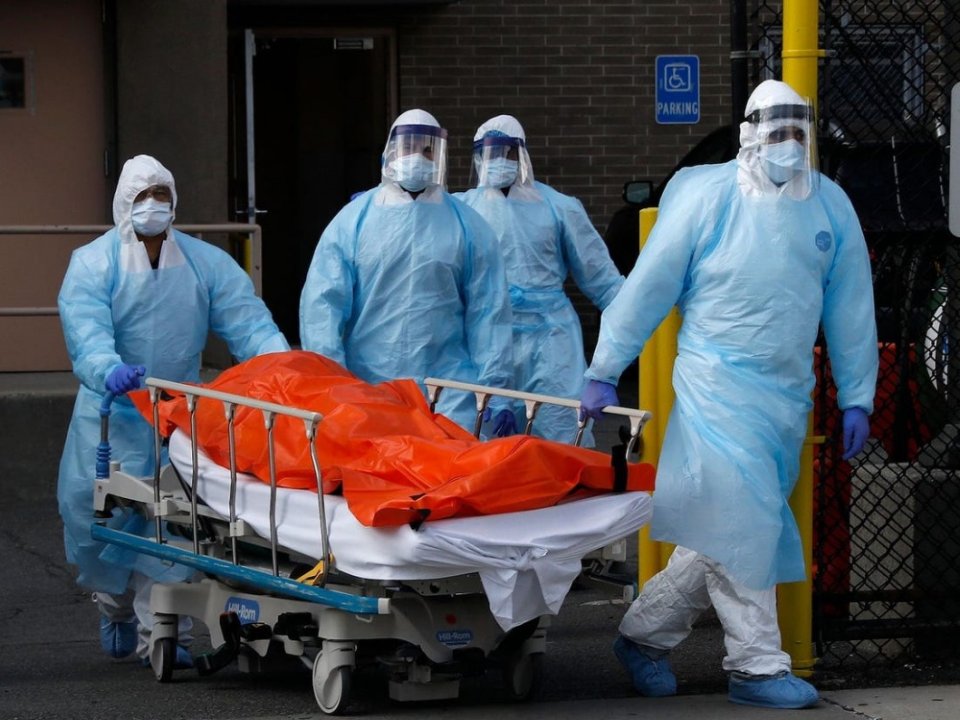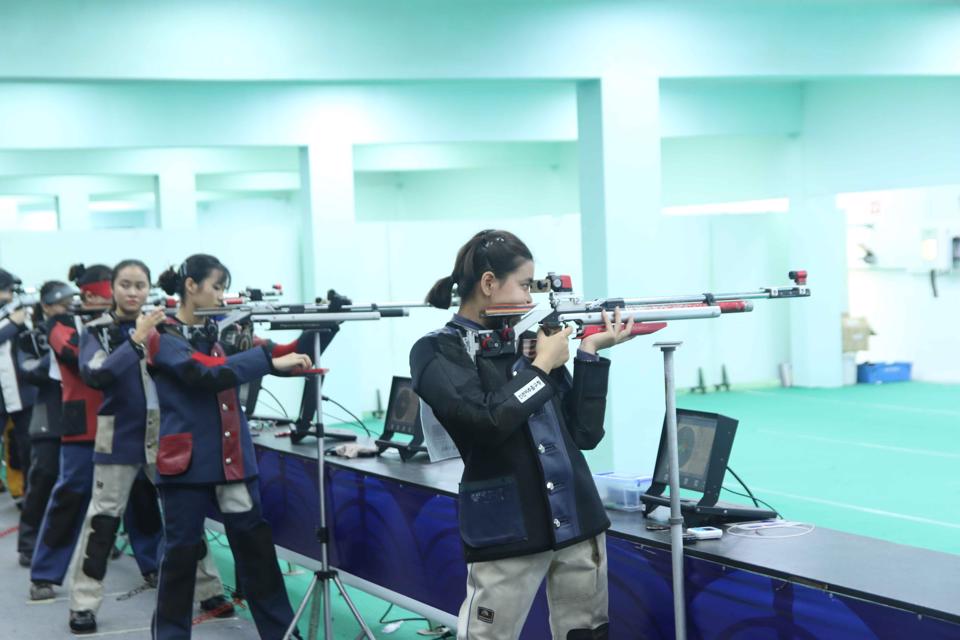The content is detailed in Official Dispatch 495/BYT-MT issued by the Ministry of Health on February 6, 2020, guiding the management of medical waste and the handling of corpses of patients who died due to nCoV infection.

07 steps for handling the bodies of Covid-19 deceased patients (Illustrative image)
To be specific, immediately upon a patient’s death due to nCoV infection, the medical facility must perform the handling of the infected body through the following 7 steps:
1. In case the room door of the deceased nCoV-infected patient does not have a tray containing disinfectant solution, a thick absorbent disinfectant-saturated cloth or mat containing 5% active chlorine solution should be placed in front of the room door. Individuals responsible for handling the body must place both feet into a stainless steel tray or onto the disinfectant-saturated cloth before leaving the room.
2. Use disinfectant-saturated cotton containing 5% active chlorine solution to seal the natural orifices of the body, then spray the entire body with a disinfectant solution containing 5% active chlorine or use a disinfectant-saturated shroud containing 5% active chlorine solution to wrap the entire body tightly.
3. Wrap the body in a body bag. Use waterproof lining material inside the body bag and seal the bag tightly. If there is no body bag, wrap the body tightly with 2 layers of thick cotton cloth saturated with a disinfectant solution containing 5% active chlorine, then wrap the body with one layer of nylon.
4. After tightly wrapping the body, use a tag or warning label "NCOV INFECTED BODY" on the outside.
5. After transferring the body, disinfect the entire patient room as follows:
- Collect dirty tools and fabrics into bins/bags according to sterilization and laundering regulations. Collect waste and other personal belongings of the deceased patient for disposal according to medical waste management guidelines in the care and treatment of nCoV-infected individuals.- Disinfect surfaces with a disinfectant solution containing 0.5% active chlorine, ensuring a chemical contact time of at least 30 minutes or use similarly approved disinfectant products as certified by the Department of Health Environmental Management - Ministry of Health.
6. Transporting the body:
6.1. Transport the body to the funeral home at the medical facility:
- Transport the body by vehicle or stretcher via a pre-designated isolation route. The wheels must be disinfected with a solution containing 0.5% active chlorine before leaving the room. Minimize transporting the body through crowded areas. If transporting by elevator, minimize the number of accompanying individuals; only those fully equipped with personal protective equipment are permitted to join.
- Immediately after bringing the body to the funeral home, disinfect the vehicle or stretcher with a solution containing 0.5% active chlorine or use similarly approved disinfectant products as certified by the Department of Health Environmental Management - Ministry of Health.
6.2. Preparing the body for burial:
- Line the bottom of the coffin with a large piece of nylon sufficient to wrap the body, place the body onto the nylon sheet at the bottom of the coffin, and wrap it tightly.- Seal the coffin tightly. Check and seal all gaps in the coffin (if any).- Disinfect all surfaces in the preparation room and items in contact with the body with a solution containing 0.5% active chlorine or use similarly approved disinfectant products as certified by the Department of Health Environmental Management - Ministry of Health.
6.3. Transporting the coffin to the cremation or burial place:
- Transport the coffin using a separate vehicle (ambulance, funeral car) to the cremation or burial site.- The family of the deceased nCoV-infected patient is not allowed to accompany the coffin transport vehicle. The driver and accompanying health workers must be fully equipped with personal protective equipment.- Immediately after transporting the coffin to the cremation or burial site, disinfect the entire surface of the coffin transport vehicle with a solution containing 0.5% active chlorine or use similarly approved disinfectant products as certified by the Department of Health Environmental Management - Ministry of Health.
6.4. Transporting bodies or remains across the border:
Follow the regulations stated in Decree 89/2018/ND-CP dated June 25, 2018, by the Government of Vietnam detailing the implementation of certain articles of the Law on Prevention and Control of Infectious Diseases concerning border health quarantine.
7. Cremation or burial of the nCoV-infected body:
7.1. Cremation:
- The body of the nCoV-infected patient must be cremated as soon as possible.- After cremation, disinfect the floor, walls, doors of the reception room, related equipment, and tools with a solution containing 0.5% active chlorine or use similarly approved disinfectant products as certified by the Department of Health Environmental Management - Ministry of Health and air-dry naturally.- Personal protective equipment of individuals involved in the cremation process must be treated as infectious waste.
7.2. Burial:
- Select a high, non-flooding area to dig the grave, and the body must be buried as soon as possible.- Before placing the coffin in the grave, sprinkle a disinfectant containing active chlorine or spray with a solution containing 5% active chlorine, or sprinkle a layer of lime powder around the walls and bottom of the grave.- Before covering with soil, sprinkle a disinfectant solution containing active chlorine or spray with a solution containing 5% active chlorine, or sprinkle a layer of lime powder around and on top of the coffin.- Tools and equipment used for burial, such as shovels, must be disinfected with a solution containing 0.5% active chlorine, allowing the tools to soak in the disinfectant for at least 30 minutes and air-dry naturally.- Personal protective equipment of individuals performing the burial must be treated as infectious waste.
Note: Handling the bodies of patients who die from acute respiratory infections caused by the novel coronavirus (nCoV) must strictly adhere to the following 07 principles:
- Ensure no disease transmission during handling, transporting, cremating, and burying the body of a patient who died from nCoV infection, and in accordance with Circular 02/2009/TT-BYT dated May 26, 2009, by the Ministry of Health guiding sanitation in burial and cremation activities.
- Transfer isolated patients in the same ward (if any) to another isolation room before handling the body.
- Bodies infected with nCoV must be cremated; burial is only allowed if cremation cannot be performed.
- The body must be prepared as soon as possible and cremated or buried within 24 hours of death.
- Only assigned healthcare staff and family members who have been instructed in preventive procedures and provided with full personal protective equipment are allowed to participate in handling the nCoV-infected body.
- Those participating in the transportation, cremation, and burial of the nCoV-infected body must be fully equipped with appropriate personal protective equipment.
- All waste generated during handling, transporting, cremating, or burying the nCoV-infected body must be treated as infectious waste.
Thu Ba
 Article table of contents
Article table of contents









